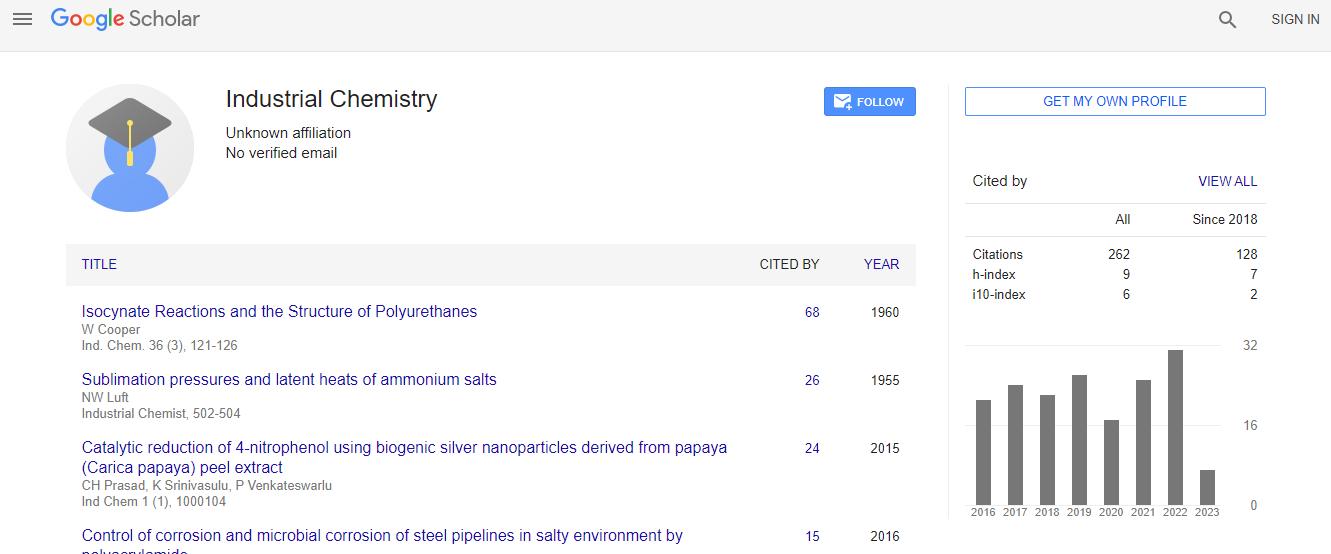Our Group organises 3000+ Global Conferenceseries Events every year across USA, Europe & Asia with support from 1000 more scientific Societies and Publishes 700+ Open Access Journals which contains over 50000 eminent personalities, reputed scientists as editorial board members.
Open Access Journals gaining more Readers and Citations
700 Journals and 15,000,000 Readers Each Journal is getting 25,000+ Readers
Google Scholar citation report
Citations : 262
Industrial Chemistry received 262 citations as per Google Scholar report
Indexed In
- Index Copernicus
- Google Scholar
- RefSeek
- Directory of Research Journal Indexing (DRJI)
- Hamdard University
- EBSCO A-Z
- OCLC- WorldCat
- Scholarsteer
- Geneva Foundation for Medical Education and Research
- Euro Pub
Useful Links
Recommended Journals
Related Subjects
Share This Page
Membrane condensers as emerging technology for water recovery from waste gaseous streams
2nd World Conference on Industrial Chemistry and Water Treatment
Adele Brunetti
The University of Calabria, Italy
ScientificTracks Abstracts: Ind Chem
Abstract
The shortage of potable water has become an environmental issue more and more pressing owing to the continuous growth in water demand not balanced by an adequate recharge. If we think the water use in power generation for boilers, cooling and cleaning purposes account for around 22% of global water consumption. Separation and recovery of water contained in the waste gaseous streams can be considered as a new water source, also simply pursuing the possibility that industry can close the own water cycle by capturing evaporated water, minimizing the make-up from external sources. In this work, an emerging technology, so-called membrane condenser for the selective removal of water from the evaporated industrial waste will be introduced. In this system, the feed (super-saturated industrial gas) is brought into contact with hydrophobic microporous membranes in membrane contactor configuration. The water condenses onto the membrane surface and the hydrophobic nature of the latter prevents the penetration of the liquid into the pores, letting the dehydrated gases pass through the membrane and retaining the liquid water at the retentive side. An experimental and simulation study is developed for predicting the membrane-based process performance. Feed flow rate, interfacial membrane area, temperature difference between the fed flue gas and the membrane module result the driving parameters controlling the process. The analysis of the potentialities of this new technology is supported by the introduction of process intensification metrics which provide an alternative and innovative point of view regarding the unit performance, highlighting important aspects characterizing the technology and not identified by the conventional analysis. In the end, this presentation aims to give a point of view on the approach to be used for a proper evaluation of emerging membrane technologies performance and comparison with conventional units.Biography
Adele Brunetti has obtained her PhD in Chemical Engineering in 2008 at the University of Calabria. In 2004, she worked at ITM-CNR in the framework of several projects at international and national level. In 2012, she has worked as a Researcher at ITM-CNR. She is the author of 50 papers published on referenced international scientific journals, 9 book chapters edited by Elsevier, Wiley, Royal Society of Chemistry and about 150 international conference proceedings. She is a Referee of several scientific journal of international level. Her research interest includes membrane condensers for water recovery; catalytic membrane reactors for high temperature reactions; design of membrane separation unit for the recovery of high purity hydrogen; study of integrated membrane plants for high purity (CO<10 ppm) hydrogen production; membrane gas separation; CO2 capture by membrane technology; testing and characterization of polymeric, zeolitic, ceramic membranes for gas separation, also in controlled relative humidity conditions.
Email: brunetti@itm.cnr.it

 Spanish
Spanish  Chinese
Chinese  Russian
Russian  German
German  French
French  Japanese
Japanese  Portuguese
Portuguese  Hindi
Hindi 